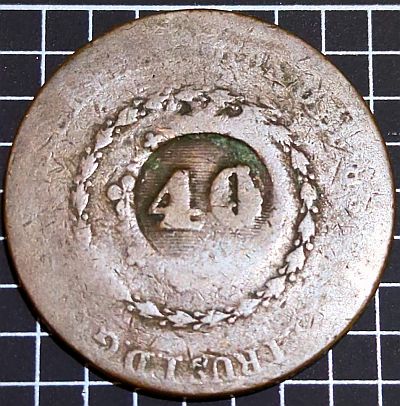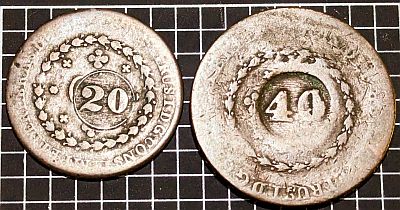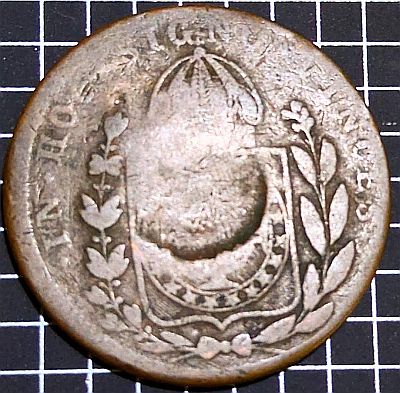A look at countermarked coins during a tumultuous period

Brazil
Brazil is the largest country in South America and the fifth largest nation in the world. Brazil has a 7,400km (4,500 mile) coastline along the Atlantic Ocean. It has borders with every South American country except Chile and Ecuador. It is known for its dense forests, including the Amazon, the world’s largest jungle, in the north. But there are also dry grasslands (called pampas), rugged hills, pine forests, sprawling wetlands, immense plateaus, and a long coastal plain.
Originally inhabited by native Amerindians, in 1500, the Portuguese, miscalculating their journey to South Africa, landed and claimed the land. They saw the potential for wood, sugar, slaves and eventually, gold.
Independence
Born in 1798, Prince Pedro of Portugal fled that country with his family at nine years old to escape the invading French army. Settling in Rio Di Janeiro in 1808, Pedro supported Brazil’s independence from Portugal. In 1822 he was proclaimed Emperor of Brazil.
In 1831, in the midst of continuing unrest, Pedro abdicated the throne, in favour of his five year old son Pedro II. Pedro returned to Portugal to remove his brother Miguel from the Portuguese throne and replaced him with his own daughter, Maria. Shortly after achieving these goals, Pedro died of tuberculosis in 1834.
Currency
When Portugal settled Brazil, they brought with them their own currency, the Real, meaning Royal. In coins, this meant the Cruzado, which was worth four Tostão, which was worth 100 Réis. Local Braizillian coins of the same denominations were issued locally from 1663.
Following independence in 1822, the Réis continued. Coins were only issued in Réis, meaning the value ranged from 10 Réis up to 6,400 Réis (gold). There were some interesting denominations, including 37 1/2 Réis as well as 40 Réis, and double both those values: 75 and 80 Réis coins as well. 80 Réis (from 1826) and larger denominations were silver, and above 960 Réis were gold.
There seems to have been a number of factors in devaluing the Brazilian currency around this time. Various wars are mentioned in this thread, as well as the Portuguese emptying the coffers as they left the new regime. VCoins mentions that (pre-1835) “nationally issued coppers varied considerably in weight, as different mints worked to different standards, depending on their region.”
Reverse

By 1835, there was an abundance of locally countermarked coppers of widely differing weights. In 1835, as an effort to standardize the currency, the government authorised official countermarks. Law #54 of 6 October 1835 ordered all coppers countermarked according to the following standards:
- 2 Oitavos = 7.18 grams = 10 Réis
- 4 Oitavos = 14.34 grams = 20 Réis
- 8 Oitavos = 28.69 grams = 40 Réis
The countermarks consist of neat numerals within a circle, having a plain or shaded field. These countermarks were applied to various Brazilian coinage from 1799 to 1833. In addition … countermarks are found on various Portuguese, Angolan, San Tome, Mozambican and pre-1799 Brazilian coins.
The process carefully covered over the original value. On the 20 Réis pictured, the edge of the 0 from 40 is partly visible (upside down, to the left of the value). Anecdotally, the dates on a lot of the donor coins seem to have been either deliberately destroyed, or lost through wear. In the 20 Réis above, the original date should be at the top of the coin. In the 40 Réis, the date is on the right edge. While a lot of the lettering on both coins is well worn, in both cases the area where the date should be is particularly bare. The re-issuance of this coin was in 1835, during the rule of Pedro II – who was only nine-years-old at the time. Although he would go on to rule for 58 years, until 1889.
Reverse

The reverse originally featured the Brazilian coat of arms. This has partly lost due to the countermark – the middle where the “40” appear on the reverse is worn plain from the impact on the obverse.
Edge

The edge is described as “Smooth with a reeded groove running circumferentially around the edge of the coin”. I always appreciate anything different to either a smooth or reeded edge.
Countermarking
Countermarking or counterstamping coins is not new. It is recorded on early Roman Imperial coins and throughout history since. Looking on Numista, the most recent example I can find is from Saudi Arabia in 1946. In this case, 12 different coins are listed, with the note: “countermarked examples of earlier types bearing the Arabic numerals 65. They were countermarked in a move to break money changers’ monopoly on small coins in AH1365 (1946AD). These countermarks vary in size and are found with the Arabic numbers raised in a circle.”
The terms countermark and counterstamp are frequently used, often interchangeably, however the difference is in how the “new” coin is made. “A countermarked coin is struck on one side only, or one side at a time, using a punch or die. A counterstamped coin is struck on both sides simultaniously using a pair of dies either in a standard mounting or sometimes with a hinged set”. Officially issued government coins then, may be either counterstamped or countermarked
Because the terms are sometimes used interchangeably, in some cases, such as searching Numista, multiple searches may be required. Numista lists:
- 1,246 coins for “countermark”
- 733 coins for “countermark”
- 235 for “counterstamp”
- 156 for “counterstamped”
- 209 for “stamped”
- 12 for “counterstruck”
And in some cases, coins may appear in multiple of those searches. For instance, this 20 Réis coin includes the terms countermarked and counterstamped.
Counterstamp is also sometimes used to describe what might otherwise be called “mintmarks”. This non-circulating 2018 Australian dollar had various letters for cities it was made in with the Royal Australian Mint’s portable press


Leave a Reply